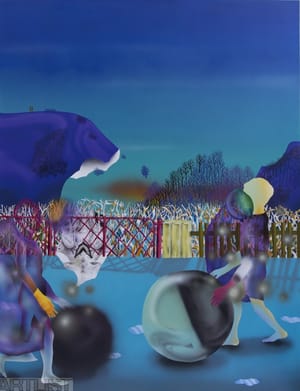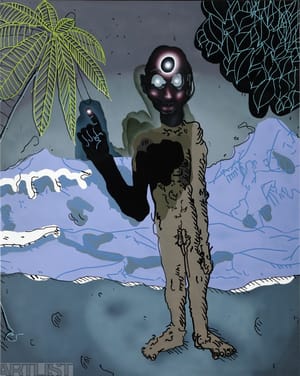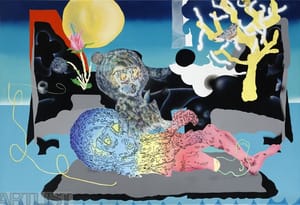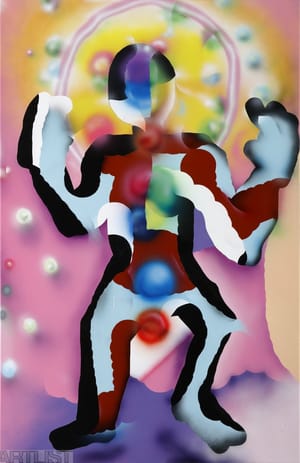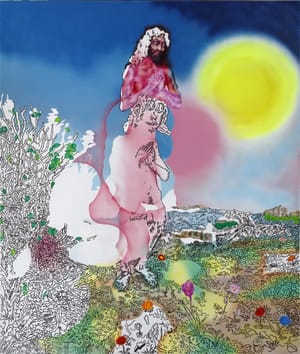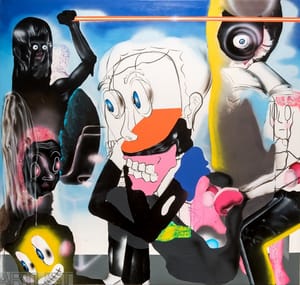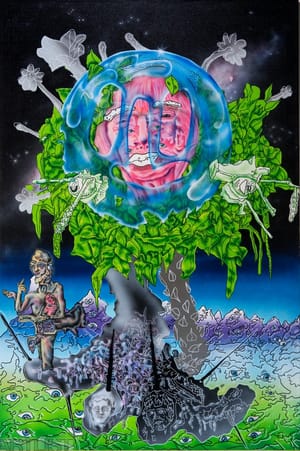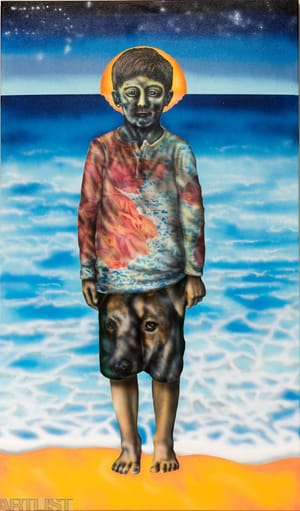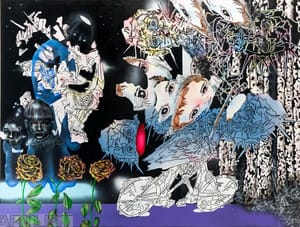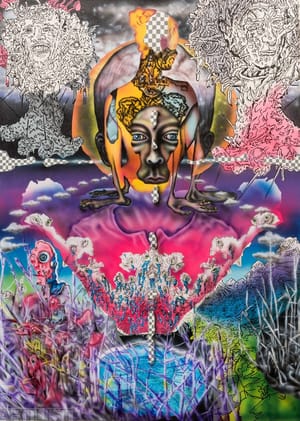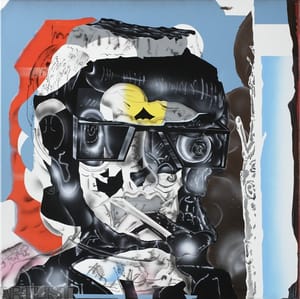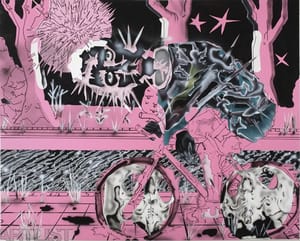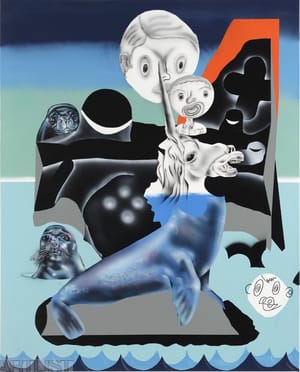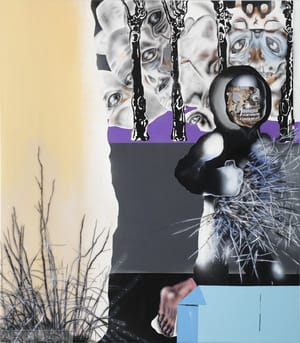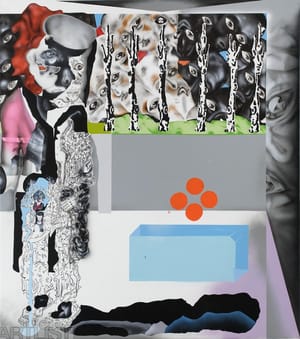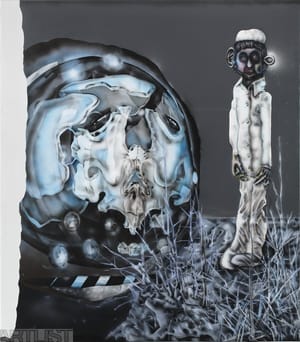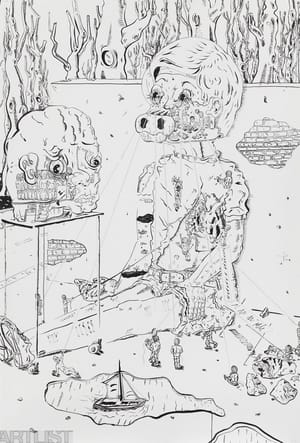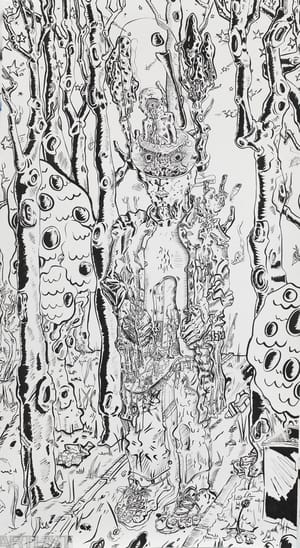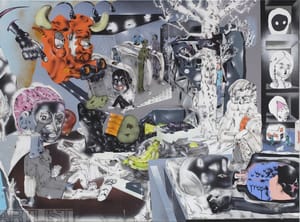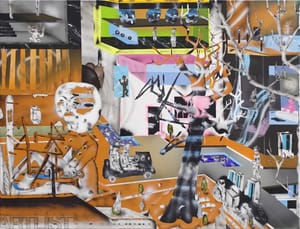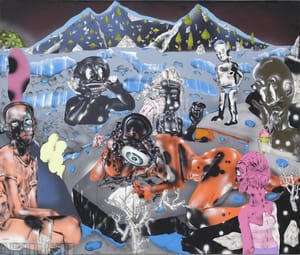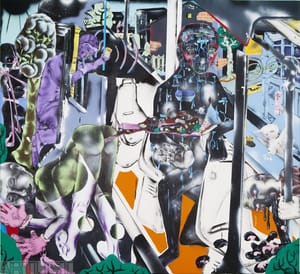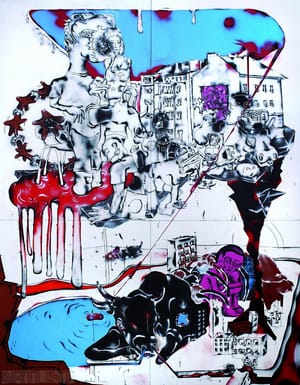- First Name
- Jakub
- Surname
- Matuška
- Other names - aliases
- Masker
- Born
- 1981
- Birth place
- Praha
- Place of work
- Praha
- Website
- http://www.masker1.net
- Keywords
- CSU Library
- ↳ Find in the catalogue
About artist
Few artist combine such contradictory elements as painter and draughtsman, creator of large murals, huge canvases and 3D objects, while remaining such an important member of the graffiti community as Jakub Matuška. The comic alternates with the tragic, dramatic tension is released in an esoteric transition to transcendence, and the general takes on the guise of a symbol in his work. It is the symbol that is so characteristic of Matuška’s work. The effort to overcome transience and to incorporate in the image, be it on the street or in a gallery, timeless information and connect this up to the restricted time and space of human life is palpable in his most recent paintings.
Play with transience is a characteristic of street art, which by definition is obliged to address ephemerality head on. The subsequent capturing or preservation of a piece in a photograph does not transcend the documentary level but simply becomes part of an ever diminishing memory. This may be one of the reasons why the important generation of graffiti artists and art school students born at the turn of the 1970s and 80s turned their attention to traditional visual media. Matuška alias Masker has never spurned the graffiti wall. However, his primary interest lies in painting and the hanging picture.
Matuška’s creative beginnings are naturally associated with his street work, with his housing estate, breakdance, night time excursions, baseball, etc., as well as with his studies at the school of graphic design and the visits he paid to the courses in figural drawing at the Academy of Arts, Architecture and Design in Prague along with other well known names from the world of graffiti (Bior, Cakes, Romeo, Vladimir 518, etc.). The combination of the freedom of pieces and tags and the discipline of his studies in draughtsmanship is not only a prelude to his later inclination to classical painting, but the epicentre of the emergence of his own style and unmistakable expression, which among other things is related to the development of a specific painterly technique.
To begin with Masker writes and draws figures so that he annihilates this letter by virtue of his move toward a visual character. One should not overlook his membership of the CAP crew, a freewheeling association of writers whose pieces became a minimalist reply to the developing line of perfect “signatures”. The visual basis of CAP was not a bombastic signature on a poorly accessed place, but a drawing, an image in the true sense of the word. And it is the drawing as core that is crucial to Masker aka the burgeoning Jakub Matuška.
It is through the drawing that we sense the housing estate, the pulse of the street and solitude, we are part of a mix of opposing emotions ranging from desperation and aggression to humility, pain and euphoria. An essential feature of Matuška’s paintings is the clutter that we can unravel and break down into individual, distinct elements so as to arrive at an overall picture. Each part is overwhelmed by significance, as though the impassiveness of the signature on a wall had to give way to a period of eruptive narration. The rollers of the CAP period make their mark along with airbrushes aka sprays or the drawn line of art brut, albeit guided by a trained hand. It is not by chance that we observe a certain consonance with the paintings of Josef Bolf, at the very least with the type of colour scheme and distinct aesthetic cruelty that might relate to similar childhood experiences.
The particular sensibility of the artist’s paintings at first sight evokes in the viewer a feeling of tension. However, this feeling opens up into a world of unbridled imagination, of which much has been written in Matuška’s case. We see not only Hieronymus Bosch, the gothic method of visual narration and the stereotypical figural motifs influenced by Henri Matisse, but also Miró and hints of Picasso’s concept of multi-view, i.e. an attempt to transcend the basic visual plan. In the most recent canvases of 2015–2016 we even find references to Dali, who, albeit with cynical intentions, loaded up his paintings with multiple meanings.
And it is here, in an effort to recount a timeless story, i.e. a myth, that we encounter in Matuška’s work the symbol. The path from sign (letter) to symbol (character) is direct. At a time when the symbols used in fine art are no longer comprehensible to the general public and when narration is more often textual than visual in nature, the attempt to capture a universal story is far from simple. Matuška draws on myth that intrudes into the present. He speaks of balance and perfection and approaches nirvana through work with the dualities already referred to: cruelty is not shown without tenderness, happiness without despair…
He is able to elevate the perfect baseball game to a holy experience, since this too is permeated by a perfection that is within reach. The simplest solution lies before us, we create complexity by virtue of our unwillingness to see and accept. Idealism ridiculed for its naivety is for Matuška the celebration of an ideal, a moral magnitude, something transcendent that we can nonetheless share and sample while still on planet earth. It can be naive and ironic, cruel and yet romantic. When describing his transcendental experience, he cannot overlook the clear link with quantum physics, the last theory that speaks of time not on the level of beginning and end but as a permanently existing presence. This is how Matuška depicts his vision. He sees his paintings in waves and layers that are forever intermingling and overlaying.
So why the symbol? Because the symbol operates as the key to understanding that the higher can also mean the lower, that the universal is also the particular. That that which transcends us is within our reach. That we are both micro and macro, we are part of a large endlessly waving map. Matuška operates in the fourth dimension. He regards his “thing” from many angles and perspectives, meanings cross and multiply, he seeks a balance in what at first sight seems like impossible deflections, in the space of entropy.
Drawn sketches can facilitate our understanding of multilayered, complicated images, and these sketches are at the same time at the core of the image. The skull is a common motif used by Matuška for its ornamental character and symbolic content. The inclusion of different individual motifs results in new paintings and the canvas must be read in layers, with each layer decoded before moving to the next. In Just Wait Hares a wolf and a hare caught in the spell of a tangle of dandelions create a portrait of Vladimir Putin, the antithesis of the then American president Obama, whose face arises by blending with that of Angela Merkel in a reference to the German author of Winnetou and the genocide of the Indians – in short it shows how many dimensions of thinking Matuška attempts to squeeze into one canvas. A frequent guide is a gloomy looking boy that we follow from childhood to puberty, i.e. probably the artist himself in the role of participant and not simply observer. Similarly visible and often used are erotic motifs that appear mainly for their biomorphic quality.
Jakub Matuška aka Masker has acquired a special status on the Czech art scene by means of an immediately identified trademark style, a demonic imagination, and the ability to economise comic-style. He is still on the path, though does not see this as a linear process but more as an ability to read multiplicities and diversities that are present in one and the same moment in the painting.
- Author of the annotation
- Klára Voskovcová
- Published
- 2017
CV
Studium: 2003–2009 Malba II, Ateliér Vladimíra Skrepla, Akademie výtvarných umění 1999–2003 Střední uměleckoprůmyslová škola, Praha Stáže, tvůrčí pobyty: 2008 Residenční pobyt v The Cooper Union for the Advancement of Science and Art, New York, USA 2007 Residenční pobyt v Middlesex University, Londýn, Velká Británie Ocenění: 2011 Cena 333, Národní galerie a Skupiny ČEZ, cena pro mladé umělce do 33 let, Praha 2010 Finalista Ceny Jindřicha Chalupeckého 2008 Cena diváků, Names Fest, Praha
- Member of art groups not included in ARTLIST.
- CAP crew
Exhibitions
- Solo exhibitions
-
2017
An Energy Figure Created in Photoshop, Galerie Dukan, Leipzig
2015
The Red Gentleman Leaves on the Water and the Devil Wears Paddles, DSC Gallery, Prague
2014
Opening June 21, Galerie Dukan, Paris
2013
Let me tell you why my head is swelling, DSC Gallery, Prague
2012
Tree Growing from his Ear, Red Gallery, London
Tree Growing from his Ear, DSC Gallery, Prague
2011
My self, GAVU, Cheb
2010
If you need something in your life, buy it yourself, Jelení gallery, Prague
2009
Masker, Kabinett, Zlín
2008
NUNUNU-NEW YORK, Karlín Studios, Prague
Drawings, KO salon, Prague
Simulant, AM 180 gallery, Prague
2007
Kamuky na Kamuky, Bodhy gallery Brick Lane, London
2006
Fax you (Together with Martin Fischer) - author book of drawings printed on fax machine released, limited edition of 100 pieces, Trafo galerie, Prague
Whatever we got, we work with, Gallery Nábřeží, Prague
2005
This is Klára, Tereza, she´s been already fired and Petra, we call her Pída, etc. galerie, Prague
- Group exhibitions not included in ARTLIST.
-
2016
RƎVƎRSƎ, DSC Gallery, Prague
2015
ET CETERA - exhibition of contemporary Czech artists, MAXXI Museum, Itálie
2014
Paper obsessed + 2, DSC Gallery, Prague
2013
ET CETERA, Italian Cultural Institute in Prague
2012
Stuck on the City, City Gallery Prague - Municipal Library
2011
NG 333 - National Gallery prize for young artist under 33 years of age, Prague
2010
Jindřich Chalupecký Award, DOX, Prague
Metropolis, DOX, Prague
Trouble with Love, Dvorak Sec Contemporary, Prague
EXPO 2010,/ Shanghai, China
Bastropilis 5. patro Galleri Bastropilis M. S. Bastian / Isabelle L. (CH), Martin Gerboc (SK)
In Crisis We Trust, The Monastery Church of Saint Antonin, Sokolov
2009
Contemporary drawing, Kasárne Kulturpark, Košice / 2. patro gallery Praha / Labor gallery, Budapest
On the other hand, Chemistry gallery, Prague
In Crisis We Trust, Trafo gallery, Prague
Exhibition of Graduates of Academy of Arts, National gallery, in Prague / Museum of Music, Polička
Art Critics' Award For Painting, Galerie kritiků, Prague
2008
Tina B- The Praha contemporary Art Festival, Praha
Names – the first international festival of street art and graffiti, Praha
2007
Laktation, Gallery Nábřeží, Praha
Street art, Communication space Školská 28, Praha
Subkultura Mystic skate cup (World Cup Skateboarding), Praha
Prague Biennale 3
2006
Tina B - represented by video in section "Huge and digital", Praha
Guest of David Böhm and Jiří Franta at It's not what it could be exhibition at NOD Gallery, Praha
Subculture (with Martin Fischer), Mystic skate cup (World Cup Skateboarding), Praha
Studio Painting II, NoD Gallery, Prague
Comics exhibition, NoD Gallery, Prague
- Collections
-
Národní galerie v Praze
Je zastupován galerií DSC.
- Other realisations
2012
Beta building foyer, BB Centre, Prague
Interior of Bistro Santinka, Prague
Interior of Brasileiro restaurant, Prague
2011
Wall painting, Elementary School, Cheb
Interior of Hospoda restaurant, New York, USA
2008
Interior of Optic Studio Zilka, Prague
Ceiling Painting in library, Castle Trebesice, FUTURA Project
2006
In Graffiti We Trust, book by Martina Overstreet, (together with Pasta), Published by Mladá Fronta
2005
Wall painting of ZOO 1320 restaurant, Liberec
Monography
- Articles
Výstava v galerii DSC ukazuje, kam došli zakladatelé českého street artu Pasta nebo Vladimir 518, Hospodářské noviny, Naďa Klevisová, 29. 7. 2016, archiv.ihned.cz/c1-65383120-reverse-vystava-dsc-gallery-epos-vladimir-518-masker-pasta-dokoupil Z ulice do galerie: Jakub Matuška je jedním z nejoriginálnějších malířů své generace, Hospodářské noviny, Naďa Klevisová, 30. 10. 2015, archiv.ihned.cz/c1-64802510-z-ulice-do-galerie-jakub-matuska-je-jednim-z-nejoriginalnejsich-maliru-sve-generace Malíř, který si říká Masker, spojil svoje obrazy se záběry z baseballu, iDNES.cz, 21. 10. 2015, kultura.zpravy.idnes.cz/jakub-matuska-masker-vystava-djj-/vytvarne-umeni.aspx Jakub Matuška aka Masker vystavuje nové malby a kresby, Blesk, %CTK, 14. 10. 2015, www.blesk.cz/clanek/zpravy-live-kulturni-servis/349166/jakub-matuska-aka-masker-vystavuje-nove-malby-a-kresby.html Český výtvarník Masker vystavuje v Paříži. Snažím se malovat rychleji, říká, Hospodářské noviny, Dak, 25. 6. 2014, art.ihned.cz/umeni/c1-62410580-masker-galerie-dukan Kam se posunulo české umění od revoluce? Italové v Praze vystavují Maskera i Týce, Hospodářské noviny, Pavel Vokatý, 20. 9. 2013, art.ihned.cz/umeni/c1-60821370-et-cetera-italsky-kulturni-institut-masker-tyc-nepras Finalista Chalupeckého ceny Masker vzal svoji sprejerskou minulost do galerie, Hospodářské noviny, Magdalena Čechlovská, 9. 3. 2012, art.ihned.cz/umeni/c1-54990840-masker-micha-sprejerskou-minulost-se-salonnim-umenim Nejistá půda pod nohama, Artalk, Pavlína Doubravová, 5. 3. 2012, artalk.cz/2012/03/05/nejista-puda-pod-nohama/ Jakub Matuška alias Masker tvrdí: Chybí mi tady přátelská atmosféra, Kateřina Farná, Právo, Novinky, 25. 10. 2012, www.novinky.cz/kultura/281777-jakub-matuska-alias-masker-tvrdi-chybi-mi-tady-pratelska-atmosfera.html Cenu 333 získal Jakub Matuška alias Masker, ČTK, 16. 12. 2011, www.tyden.cz/rubriky/kultura/umeni/cenu-333-ziskal-jakub-matuska-alias-masker_220273.html Cenu 333 pro mladé výtvarníky dostal představitel street artu Masker, Idnes.CZ, 16. 12. 2011, kultura.zpravy.idnes.cz/cenu-333-pro-mlade-vytvarniky-dostal-predstavitel-street-artu-masker-1gm-/vytvarne-umeni.aspxwww.galeriejeleni.cz/vystavy/2010/jakub-matuska-aka-masker-kdyby-si-v-zivote-nekdy-neco-potreboval-tak-si-to-kup/ Jakub Matuška, Art and Antiques, Kateřina Tučková, leden 2008, www.artcasopis.cz/clanky/jakub-matuska

